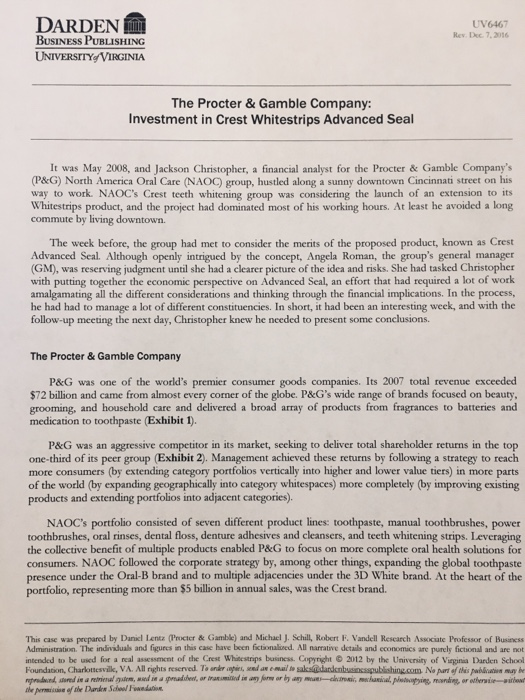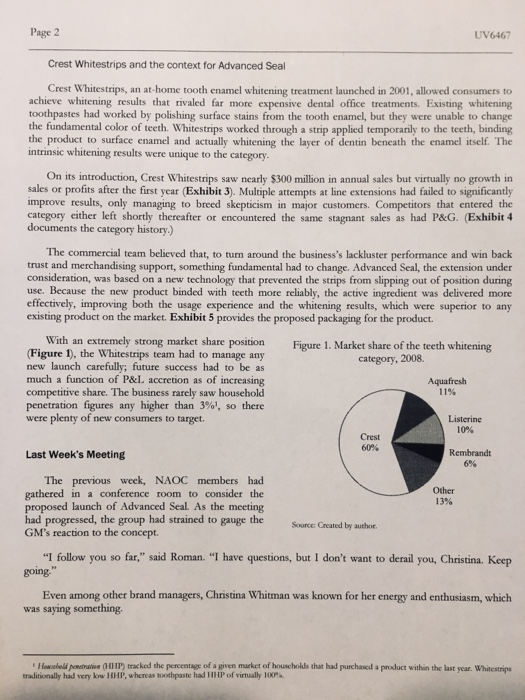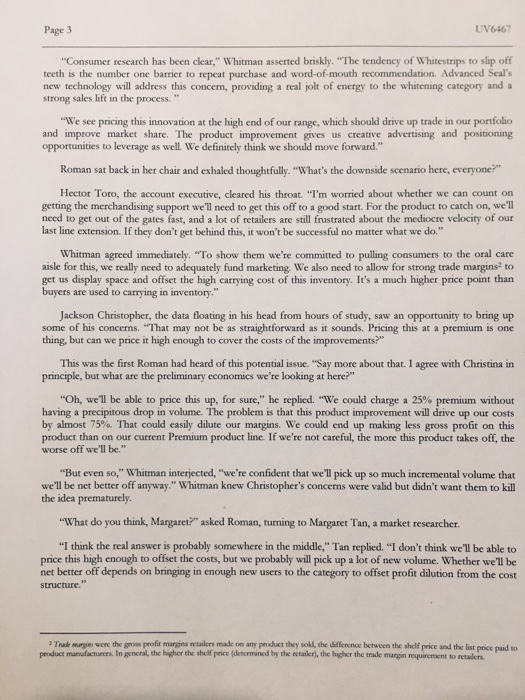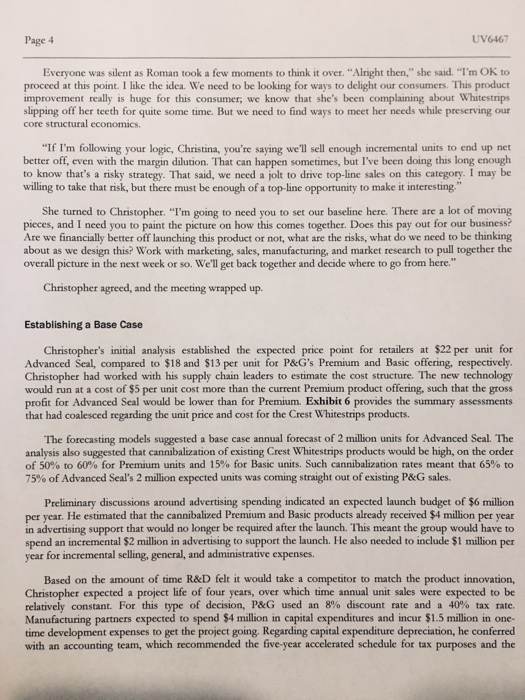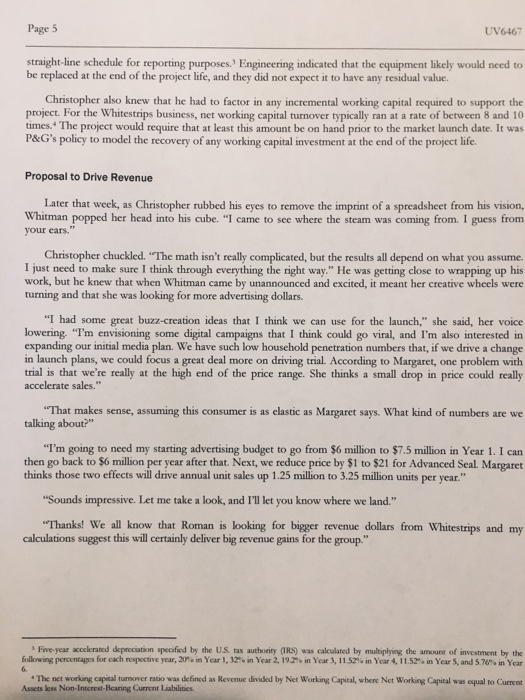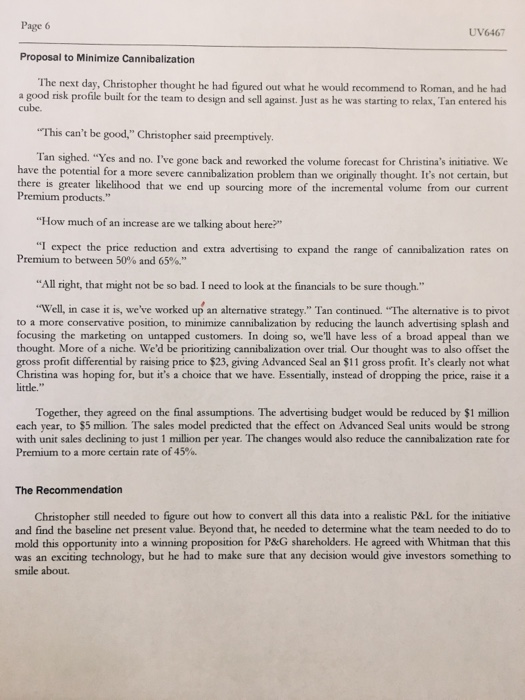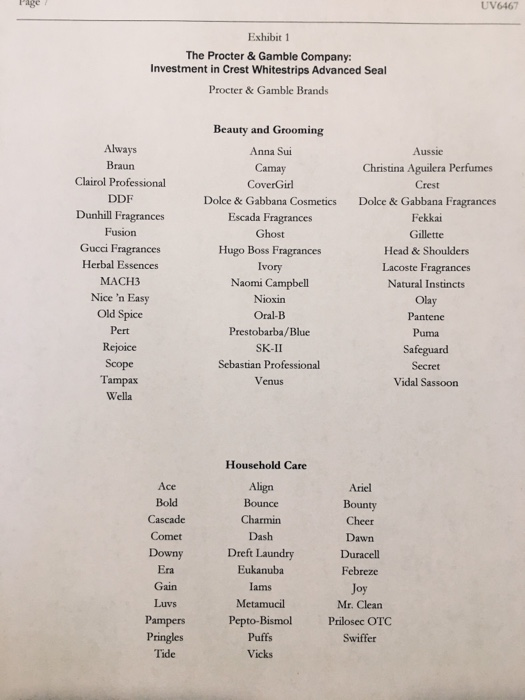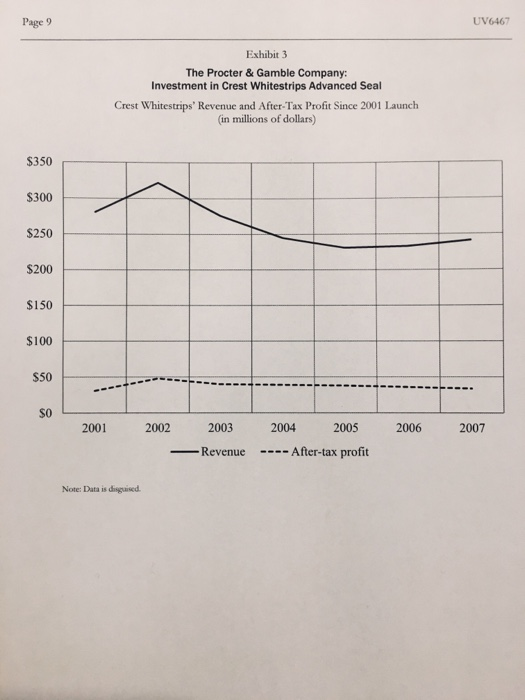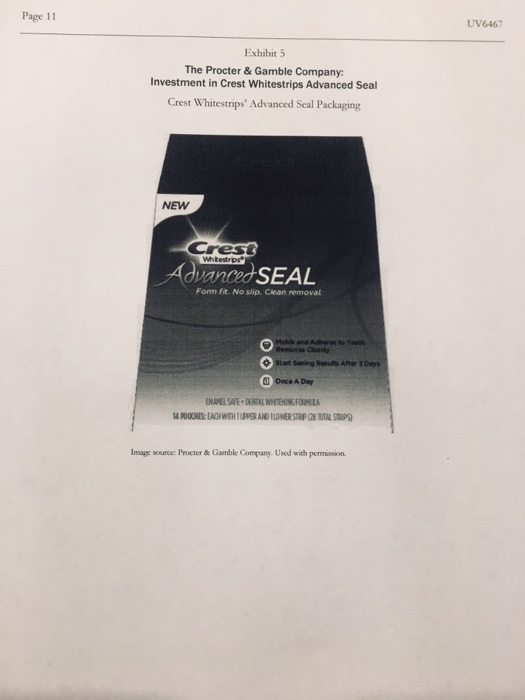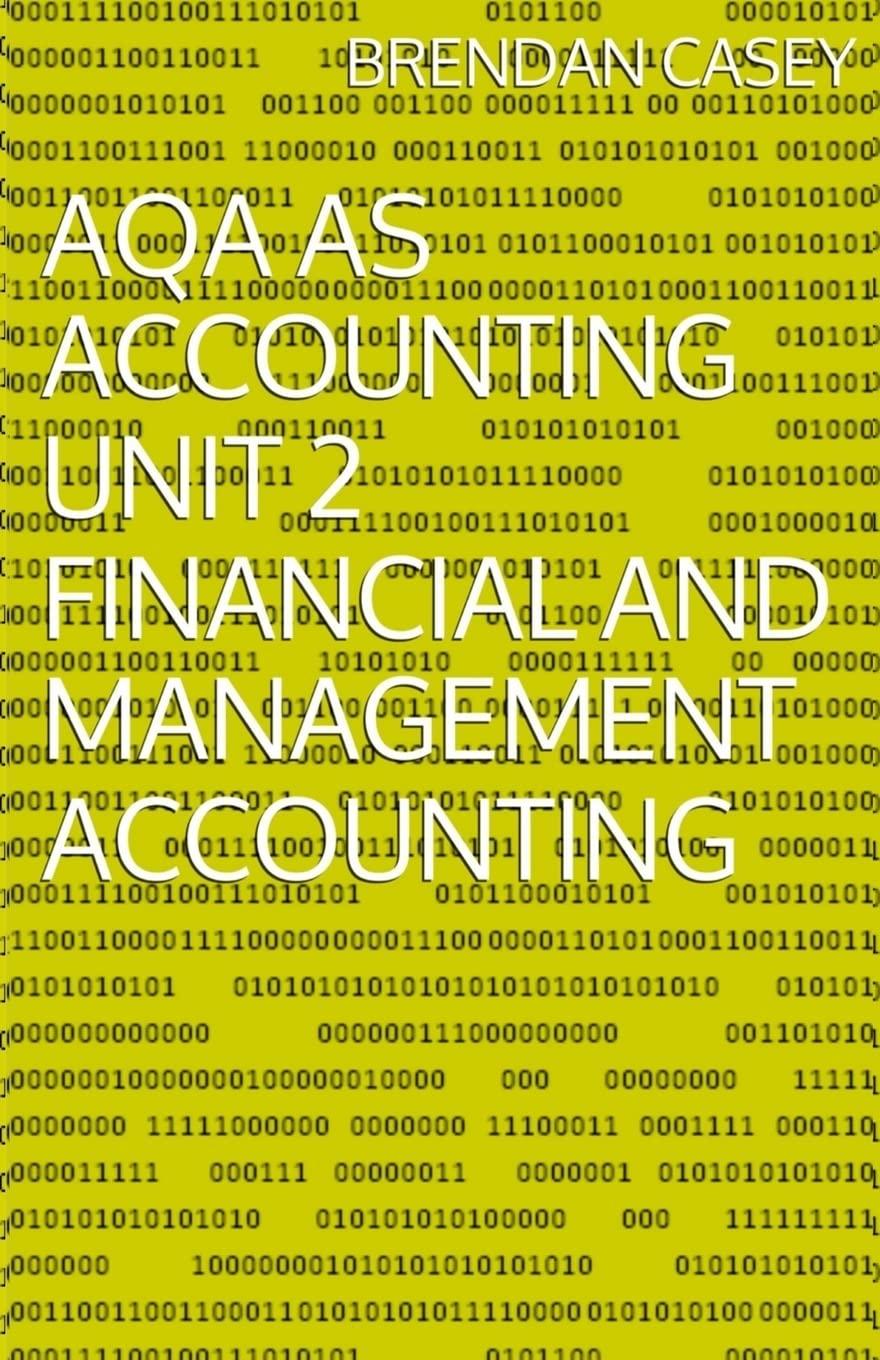Please see first picture for questions.
Thank you! Greatly rewarded!
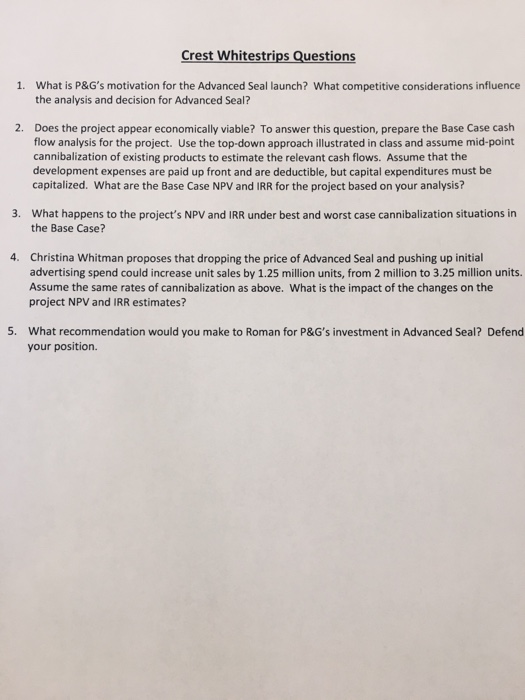
Crest Whitestrips Questions 1. What is P&G's motivation for the Advanced Seal launch? What competitive considerations influence the analysis and decision for Advanced Seal? 2. Does the project appear economically viable? To answer this question, prepare the Base Case cash flow analysis for the project. Use the top-down approach illustrated in class and assume mid-point cannibalization of existing products to estimate the relevant cash flows. Assume that the development expenses are paid up front and are deductible, but capital expenditures must be capitalized. What are the Base Case NPV and IRR for the project based on your analysis? 3. What happens to the project's NPV and IRR under best and worst case cannibalization situations in the Base Case? 4. Christina Whitman proposes that dropping the price of Advanced Seal and pushing up initial advertising spend could increase unit sales by 1.25 million units, from 2 million to 3.25 million units. Assume the same rates of cannibalization as above. What is the impact of the changes on the project NPV and IRR estimates? 5. What recommendation would you make to Roman for P&G's investment in Advanced Seal? Defend your position. DARDEN BUSINESs PUBLISHING UNIVERSTY/VRGINIA UV6467 Rev. Dec. 7, 2036 The Procter& Gamble Company: Investment in Crest Whitestrips Advanced Seal It was May 2008, and Jackson Christopher, a financial analyst for the Procter&Gamble Company's (P&G) North America Oral Care (NAOC) group, hustled along a sunny downtown Cincinnati street on his way to work NAOC's Crest teeth whitening group was considering the launch of an extension to its Whitestrips product, and the project had dominated most of his working hours. At least he avoided a long commute by living downtown. The week before, the group had met to consider the merits of the proposed product, known as Crest Advanced Seal. Although openly intrigued by the concept, Angela Roman, the group's general manager (GM), was reserving judgment until she had a clearer picture of the idea and risks. She had tasked Christopher with putting together the economic perspective on Advanced Seal, an effort that had required a lot of work amalgamating all the different considerations and thinking through the financial implications. In the process, he had had to manage a lot of different constituencies. In short, it had been an interesting week, and with the follow-up meeting the next day, Christopher knew he needed to present some conclusions. The Procter & Gamble Company P&G was one of the world's premier consumer goods companies. Its 2007 total revenue exceeded $72 billon and came from almost every corner of the globe. P&G's wide range of brands focused on beauty grooming, and household care and delivered a broad array of products from fragrances to batteries and medication to toothpaste (Exhibit 1) P&G was an aggressive competitor in its market, seeking to deliver total shareholder returns in the top one-third of its peer group (Exhibit 2). Management achieved these returns by following a strategy to reach more consumers (by extending category portfolios vertically into higher and lower value tiers) in more parts of the world (by expanding geographically into category whitespaces) more completely (by improving existing products and extending portfolios into adjacent categories). NAOC's portfolio consisted of seven different product lines: toothpaste, manual toothbrushes, power toothbrushes, oral rinses, dental floss, denture adhesives and cleansers, and teeth whitening strips. Leveraging the collective benefit of multiple products enabled P&G to focus on more complete oral health solutions for consumers. NAOC followed the corporate strategy by, among other things, expanding the global toothpaste presence under the Oral-B brand and to multiple adjacencies under the 3D White brand. At the heart of the portfolio, representing more than $5 billion in annual sales, was the Crest brand. This case was prepared by Danicl Lentz (Procter& Gamble) and Michacl J. Schill, Robert F. Vandell Research Associate Professor of Business Administration. The individuals and figurecs in this case have been fictionalived. All narrative details and economics are purely fictional and are not intended t) bc ased for a real assessment of the Crest Whaestr ps business. Copyright 2012 by the University of Vegna Dar en School Foundation, Charlotsesvilk, VA. All rights reserved. Ta aner npie, end as email o saksdandenbusinssspublishing.com No part of this pblivation may be permiuse of she Darden School Iwasa UV6467 Crest Whitestrips and the context for Advanced Seal Crest Whitestrips, an at-home tooth enamel whitening treatment launched in 2001, allowed consumers to achieve whitening results that rivaled far more expensive dental office treatments. Existing whitening toothpastes had worked by polishing surface stains from the tooth enamel, but they were unable to change the fundamental color of teeth. Whitestrips worked through a strip applied temporarily to the teeth, binding the product to surface enamel and actually whitening the layer of dentin beneath the enamel itself. The intrinsic whitening results were unique to the category On its introduction, Crest Whitestrips saw nearly $300 million in annual sales but virtually no growth in sales or profits after the first year (Exhibit 3). Multiple attempts at line extensions had failed to significantly improve results, only managing to breed skepticism in major customers. Competitors that entered the category either left shortly thereafter or encountered the same stagnant sales as had P&G. (Exhibit 4 documents the category history.) The commercial team believed that, to turn around the business's lackluster performance and win back trust and merchandising support, something fundamental had to change. Advanced Seal, the extension under consideration, was based on a new technology that prevented the strips from slipping out of position during use. Because the new product binded with teeth more reliably, the active ingredient was delivered more effectively, improving both the usage experience and the whitening results, which were superior to any existing product on the market. Exhibit 5 provides the proposed packaging for the product. With an extremely strong market share position Figure 1. Market share of the teeth whitening Figure 1), the Whitestrips team had to manage any new launch carefully; future success had to be as much a function of P&L accretion as of increasing competitive share. The business rarely saw household penetration figures any higher than 3%, so there were plenty of new consumers to target. category, 2008. Aquafresh 11% Listerine 10% Crest 60% Rembrandt 6% Last Week's Meeting The previous week, NAOC members had gathered in a conference room to consider the proposed launch of Advanced Seal. As the meeting had progressed, the group had strained to gauge the urce Created GM's reaction to the concept. Other 13% "I follow you so far," said Roman. "I have questions, but I don't want to derail you, Christina. Keep going Even among other brand managers, Christina Whitman was known for her energy and enthusiasm, which was saying something Hweeld onst011P) tracked the pencentage of a given market of houscholds that had purchased a product within the last year. Whitestrips tralitionally had very kw HHP, whereas toothpaste had HHI) of virtually 100%. UV6467 Page 3 "Consumer research has been clear," Whitman asserted briskly. "The tendency of Whitestrips to slip off teeth is the number one barrier to repeat purchase and word-of-mouth recommendation. Advanced Seal's new technology will address this concem, providing a real jolt of energy to the whitening category and a strong sales lift in the process." "We see pricing this innovation at the high end of our range, which should drive up trade in our portfoio and improve market share. The product improvement gives us creative advertising and positioning opportunities to leverage as well We definitely think we should move forward." Roman sat back in her chair and exhaled thoughtfully. "What's the downside scenario here, everyone?" Hector Toro, the account executive, cleared his throat. "T'm worried about whether we can count on getting the merchandising support we'll need to get this off to a good start. For the product to catch on, we'll need to get out of the gates fast, and a lot of retailers are still frustrated about the mediocre velocity of our last line extension. If they don't get behind this, it won't be successful no matter what we do." Whitman agreed mmediately .. To show them we're committed to pulling consumers to the oral care aisle for this, we really need to adequately fund marketing We also need to allow for strong trade margins? to get us display space and offset the high carrying cost of this inventory. It's a much higher price point than buyers are used to carrying in inventory. Jackson Christopher, the data floating in his head from hours of study, saw an opportunity to bring up some of his concerns. "That may not be as straightforward as it sounds. Pricing this at a premium is one thing, but can we price it high enough to cover the costs of the improvements?" This was the first Roman had heard of this potential issue. "Say more about that. I agree with Christina in principle, but what are the preliminary economics we're looking at here?" "Oh, we'll be able to price this up, for sure," he replied ."We could charge a 25% premium without having a precipitous drop in volume. The problem is that this product improvement will drive up our costs by almost 75%. That could easily dilute our margins, we could end up making less gross profit on this product than on our current Premium product line. If we're not careful, the more this product takes off, the worse off we'll be." "But even so," Whitman interjected, "we're confident that we'll pick up so much incremental volume that we'll be net better off anyway." Whitman knew Christopher's concerns were valid but didn't want them to kill the idea prematurely What do you think, Margaret?" asked Roman, turning to Margaret Tan, a market researcher. "I think the real answer is probably somewhere in the middle," Tan replied. "I don't think we'll be able to price this high enough to offset the costs, but we probably will pick up a lot of new volume. Whether we'll be net better off depends on bringing in enough new users to the category to offset profit dilution from the cost Truk mrpe, were the grou pofit marpris fetaler, ma amy proact they sold, the flerence between the shelf pr ce and the list price pad to peoduct manufactueers. In gencral, the higher the shelf price (descemined by the eetailer), the higher the trade mangin requirement to retailers UV6467 Page 4 Everyone was silent as Roman took a few moments to think it over. "Alright then," she said. "I'm OK to proceed at this point. I like the idea. We need to be looking for ways to delight our consumers. This product improvement really is huge for this consumer, we know that she's been complaining about Whitestrips slipping off her teeth for quite some time. But we need to find ways to meet her needs while preserving our core structural economics. "If I'm following your logic, Christina, you're saying we'll sell enough incremental units to end up net better off, even with the margin dilution. That can happen sometimes, but I've been doing this long enough to know that's a risky strategy. That said, we need a jolt to drive top-line sales on this category. I may be willing to take that risk, but there must be enough of a top-line opportunity to make it interesting. She turned to Christopher. "I'm going to need you to set our baseline here. There are a lot of moving pieces, and I need you to paint the picture on how this comes together. Does this pay out for our business? Are we financially better off launching this product or not, what are the risks, what do we need to be thinking about as we design this? Work with marketing, sales, manufacturing, and market research to pull together the overall picture in the next week or so. We'll get back together and decide where to go from here." Christopher agreed, and the meeting wrapped up. Establishing a Base Case Christopher's initial analysis established the expected price point for retailers at $22 per unit for Advanced Seal, compared to $18 and $13 per unit for P&G's Premium and Basic offering, respectively Christopher had worked with his supply chain leaders to estimate the cost structure. The new technology would run at a cost of $5 per unit cost more than the current Premium product offering, such that the gross profit for Advanced Seal would be lower than for Premium. Exhibit 6 provides the summary assessments that had coalesced regarding the unit price and cost for the Crest Whitestrips products. The forecasting models suggested a base case annual forecast of 2 million units for Advanced Seal. The analysis also suggested that cannibalization of existing Crest Whitestrips products would be high, on the order of 50% to 60% for Premium units and 15% for Basic units. Such cannibalization rates meant that 65% to 75% of Advanced Seal's 2 million expected units was coming straight out of existing P&G sales. Preliminary discussions around advertising spending indicated an expected launch budget of $6 million per year. He estimated that the cannibalized Premium and Basic products already received $4 million per year in advertising support that would no longer be required after the launch. This meant the group would have to spend an incremental $2 million in advertising to support the launch. He also needed to include $1 million per year for incremental selling, general, and administrative expenses. Based on the amount of time R&D felt it would take a competitor to match the product innovation, Christopher expected a project life of four years, over which time annual unit sales were expected to be relatively constant. For this type of decision, P&G used an 8% discount rate and a 40% tax rate. Manufacturing partners expected to spend $4 million in capital expenditures and incur $1.5 million in one- time development expenses to get the project going, Regarding capital expenditure depreciation, he conferred with an accounting team, which recommended the five-year accelerated schedule for tax purposes and the Page 5 UV6467 straight-line schedule for reporting purposes. Engineering indicated that the equipment likely would need to be replaced at the end of the project life, and they did not expect it to have any residual value. Christopher also knew that he had to factor in any incremental working capital required to support the project. For the Whitestrips business, net working capital turnover typically ran at a rate of between 8 and 10 times. The project would require that at least this amount be on hand prior to the market launch date. It was P&G's policy to model the recovery of any working capital investment at the end of the project life. Proposal to Drive Revenue Later that week, as Christopher rubbed his eyes to remove the imprint of a spreadsheet from his vision, Whitman popped her head into his cube. "I came to see where the steam was coming from. I guess from your ears. Christopher chuckled. "The math isn't really complicated, but the results all depend on what you assume. I just need to make sure I think through everything the right way." He was getting close to wrapping up his work, but he knew that when Whitman came by unannounced and excited, it meant her creative wheels were turning and that she was looking for more advertising dollars. "I had some great buzz-creation ideas that I think we can use for the launch," she said, her voice lowering. "I'm envisioning some digital campaigns that I think could go viral, and I'm also interested in expanding our initial media plan. We have such low household penetration numbers that, if we drive a change in launch plans, we could focus a great deal more on driving trial According to Margaret, one problem with trial is that we're really at the high end of the price range. She thinks a small drop in price could really accelerate sales." "That makes sense, assuming this consumer is as elastic as Margaret says. What kind of numbers are we talking about?" "I'm going to need my starting advertising budget to go from $6 million to $7.5 million in Year 1. I can then go back to $6 million per year after that. Next, we reduce price by $1 to $21 for Advanced Seal. Margaret thinks those two effects will drive annual unit sales up 1.25 million to 3.25 million units per year." "Sounds impressive. Let me take a look, and I'll let you know where we land." "Thanks! We all know that Roman is looking for bigger revenue dollars from Whitestrips and my calculations suggest this will certainly deliver big revenue gains for the group." Five-year accelerated depreciation specified by the US tas authority (IRS) was calculated by multiplying the amount of investment by the following percentages for cach rorective year, ar. in Year 1, 32% n Year 2, 192', in Year 3, 1132% in Year 4, 1 LSZn Year 5, and She, in Year 6. The net working capital tumover ratio was defined as Revenue divided by Net Working Capital, where Net Working Capital was equal to Current Assets less Non-Intcrest-Bearing Current Liabilities Page 6 UV6467 Proposal to Minimize Cannibalization The next day, Christopher thought he had figured out what he would recommend to Roman, and he had a good risk profile built for the team to design and sell against. Just as he was starting to relax, Tan entered his cube. "This can't be good," Christopher said preemptively Tan sighed. "Yes and no. I've gone back and reworked the volume forecast for Christina's initiative. We have the potential for a more severe cannibalization problem than we originally thought. It's not certain, but there is greater likelihood that we end up sourcing more of the incremental volume from our current Premium products." "How much of an incresse ste we tlking about here?" "I expect the price reduction and extra advertising to expand the range of cannibalization rates on Premium to between 50% and 65%." "All right, that might not be so bad. I need to look at the financials to be sure though." "Well, in case it is, we've worked up an alternative strategy." Tan continued. "The alternative is to pivot to a more conservative position, to minimize cannibalization by reducing the launch advertising splash and focusing the marketing on untapped customers. In doing so, we'll have less of a broad appeal than we thought. More of a niche. We'd be prioritizing cannibalization over trial. Our thought was to also offset the gross profit differential by raising price to $23, giving Advanced Seal an $11 gross profit. It's clearly not what Christina was hoping for, but it's a choice that we have. Essentially, instead of dropping the price, raise it a little." Together, they agreed on the final assumptions. The advertising budget would be reduced by $1 million each year, to $5 million. The sales model predicted that the effect on Advanced Seal units would be strong with unit sales declining to just 1 million per year. The changes would also reduce the cannibalization rate for Premium to a more certain rate of 45%, The Recommendation Christopher still needed to figure out how to convert all this data into a realistic P&L for the initiative and find the baseline net present value. Beyond that, he needed to determine what the team needed to do to mold this opportunity into a winning proposition for P&G shareholders. He agreed with Whitman that this was an exciting technology, but he had to make sure that any decision would give investors something to smile about. UV6467 Palge Exhibit 1 The Procter & Gamble Company: Investment in Crest Whitestrips Advanced Seal Procter & Gamble Brands Beauty and Grooming Anna Sui Always Braun Clairol Professional DDF Dunhill Fragrances Aussie Christina Aguilera Perfumes Crest Dolce & Gabbana Fragrances Fekkai Gillette Head & Shoulders Lacoste Fragrances Natural Instincts Olay Pantene Puma Safeguard Secret Vidal Sassoon CoverGirl Dolce & Gabbana Cosmetics Escada Fragrances Ghost Hugo Boss Fragrances Ivory Naomi Campbell Nioxin Oral-B Prestobarba/Blue SK-II Sebastian Professional Venus Gucci Fragrances Herbal Essences MACH3 Nice 'n Easy Old Spice Pert Tampax Wella Household Care Ariel Bounty Cheer Dawn Duracell Febreze Joy Mr. Clean Prilosec OTC Swiffer Bold Cascade Comet Downy Era Gain Luvs Pampers Pringles Tide Bounce Charmin Dash Dreft Laundry Eukanuba lams Metamucil Pepto-Bismol Puffs Vicks UV6467 Page 8 Exhibit 2 The Procter & Gamble Company: Investment in Crest Whitestrips Advanced Seal Value of $1 Invested in P&G Stock and the S&P 500 Index, 2001 to 2008 S2.5 $2.0 $1.0 $0.5 S0.0 Jan-97 Jan-98 Jan-99 Jan-00 Jan-01 Jan-02 Jan-03 Jan-04 S&P500 PG Data source Yahool Finance. Page 9 UV6467 Exhibit 3 The Procter &Gamble Company Investment in Crest Whitestrips Advanced Seal Crest Whitestrips' Revenue and After-Tax Profit Since 2001 Launch (in millions of dollars) $350 S300 $250 $200 $150 $100 $50 s0 2001 2002 2003 2004 2005 2006 2007 RevenueAfter-tax profit Note: Data is disguised. Page 10 UV6467 Exhibit 4 The Procter & Gamble Company Investment in Crest Whitestrips Advanced Seal Whitening Category History May 2001 Apr 2003 Sep 2003 Jan 2004 Apr 2005 Jul 2007 May Jan 2005 2007 Sep 2004 Sept May Oct 2002 2003 Apr 2005 Jan 2006 Mar 2007 Mar 2008 2003 Private Label Image source: Procter & Gamble Company. Used with pernnission. UV6467 Page 11 Exhibit 5 The Procter&Gamble Company: Investment in Crest Whitestrips Advanced Seal Crest Whitestrips Advanced Seal Packaging NEW Advanted SEAL Form fit. No slip, Clean removal Once A Day NANEL SAFE DENTAL WHTENING FORA Image source: Procter&Gamble Company. Usod with permission UV6467 Page 12 Exhibit 6 The Procter &Gamble Company: Investment in Crest Whitestrips Advanced Seal Gross Profit Comparison Basic Product Premium Product Advanced Seal Per unit revenue and costs Revenue $13 $6 $18 $7 $11 $22 Cost of goods sold expenses S12 su s7 $10 Gross proft Note: Data is disguised. Crest Whitestrips Questions 1. What is P&G's motivation for the Advanced Seal launch? What competitive considerations influence the analysis and decision for Advanced Seal? 2. Does the project appear economically viable? To answer this question, prepare the Base Case cash flow analysis for the project. Use the top-down approach illustrated in class and assume mid-point cannibalization of existing products to estimate the relevant cash flows. Assume that the development expenses are paid up front and are deductible, but capital expenditures must be capitalized. What are the Base Case NPV and IRR for the project based on your analysis? 3. What happens to the project's NPV and IRR under best and worst case cannibalization situations in the Base Case? 4. Christina Whitman proposes that dropping the price of Advanced Seal and pushing up initial advertising spend could increase unit sales by 1.25 million units, from 2 million to 3.25 million units. Assume the same rates of cannibalization as above. What is the impact of the changes on the project NPV and IRR estimates? 5. What recommendation would you make to Roman for P&G's investment in Advanced Seal? Defend your position. DARDEN BUSINESs PUBLISHING UNIVERSTY/VRGINIA UV6467 Rev. Dec. 7, 2036 The Procter& Gamble Company: Investment in Crest Whitestrips Advanced Seal It was May 2008, and Jackson Christopher, a financial analyst for the Procter&Gamble Company's (P&G) North America Oral Care (NAOC) group, hustled along a sunny downtown Cincinnati street on his way to work NAOC's Crest teeth whitening group was considering the launch of an extension to its Whitestrips product, and the project had dominated most of his working hours. At least he avoided a long commute by living downtown. The week before, the group had met to consider the merits of the proposed product, known as Crest Advanced Seal. Although openly intrigued by the concept, Angela Roman, the group's general manager (GM), was reserving judgment until she had a clearer picture of the idea and risks. She had tasked Christopher with putting together the economic perspective on Advanced Seal, an effort that had required a lot of work amalgamating all the different considerations and thinking through the financial implications. In the process, he had had to manage a lot of different constituencies. In short, it had been an interesting week, and with the follow-up meeting the next day, Christopher knew he needed to present some conclusions. The Procter & Gamble Company P&G was one of the world's premier consumer goods companies. Its 2007 total revenue exceeded $72 billon and came from almost every corner of the globe. P&G's wide range of brands focused on beauty grooming, and household care and delivered a broad array of products from fragrances to batteries and medication to toothpaste (Exhibit 1) P&G was an aggressive competitor in its market, seeking to deliver total shareholder returns in the top one-third of its peer group (Exhibit 2). Management achieved these returns by following a strategy to reach more consumers (by extending category portfolios vertically into higher and lower value tiers) in more parts of the world (by expanding geographically into category whitespaces) more completely (by improving existing products and extending portfolios into adjacent categories). NAOC's portfolio consisted of seven different product lines: toothpaste, manual toothbrushes, power toothbrushes, oral rinses, dental floss, denture adhesives and cleansers, and teeth whitening strips. Leveraging the collective benefit of multiple products enabled P&G to focus on more complete oral health solutions for consumers. NAOC followed the corporate strategy by, among other things, expanding the global toothpaste presence under the Oral-B brand and to multiple adjacencies under the 3D White brand. At the heart of the portfolio, representing more than $5 billion in annual sales, was the Crest brand. This case was prepared by Danicl Lentz (Procter& Gamble) and Michacl J. Schill, Robert F. Vandell Research Associate Professor of Business Administration. The individuals and figurecs in this case have been fictionalived. All narrative details and economics are purely fictional and are not intended t) bc ased for a real assessment of the Crest Whaestr ps business. Copyright 2012 by the University of Vegna Dar en School Foundation, Charlotsesvilk, VA. All rights reserved. Ta aner npie, end as email o saksdandenbusinssspublishing.com No part of this pblivation may be permiuse of she Darden School Iwasa UV6467 Crest Whitestrips and the context for Advanced Seal Crest Whitestrips, an at-home tooth enamel whitening treatment launched in 2001, allowed consumers to achieve whitening results that rivaled far more expensive dental office treatments. Existing whitening toothpastes had worked by polishing surface stains from the tooth enamel, but they were unable to change the fundamental color of teeth. Whitestrips worked through a strip applied temporarily to the teeth, binding the product to surface enamel and actually whitening the layer of dentin beneath the enamel itself. The intrinsic whitening results were unique to the category On its introduction, Crest Whitestrips saw nearly $300 million in annual sales but virtually no growth in sales or profits after the first year (Exhibit 3). Multiple attempts at line extensions had failed to significantly improve results, only managing to breed skepticism in major customers. Competitors that entered the category either left shortly thereafter or encountered the same stagnant sales as had P&G. (Exhibit 4 documents the category history.) The commercial team believed that, to turn around the business's lackluster performance and win back trust and merchandising support, something fundamental had to change. Advanced Seal, the extension under consideration, was based on a new technology that prevented the strips from slipping out of position during use. Because the new product binded with teeth more reliably, the active ingredient was delivered more effectively, improving both the usage experience and the whitening results, which were superior to any existing product on the market. Exhibit 5 provides the proposed packaging for the product. With an extremely strong market share position Figure 1. Market share of the teeth whitening Figure 1), the Whitestrips team had to manage any new launch carefully; future success had to be as much a function of P&L accretion as of increasing competitive share. The business rarely saw household penetration figures any higher than 3%, so there were plenty of new consumers to target. category, 2008. Aquafresh 11% Listerine 10% Crest 60% Rembrandt 6% Last Week's Meeting The previous week, NAOC members had gathered in a conference room to consider the proposed launch of Advanced Seal. As the meeting had progressed, the group had strained to gauge the urce Created GM's reaction to the concept. Other 13% "I follow you so far," said Roman. "I have questions, but I don't want to derail you, Christina. Keep going Even among other brand managers, Christina Whitman was known for her energy and enthusiasm, which was saying something Hweeld onst011P) tracked the pencentage of a given market of houscholds that had purchased a product within the last year. Whitestrips tralitionally had very kw HHP, whereas toothpaste had HHI) of virtually 100%. UV6467 Page 3 "Consumer research has been clear," Whitman asserted briskly. "The tendency of Whitestrips to slip off teeth is the number one barrier to repeat purchase and word-of-mouth recommendation. Advanced Seal's new technology will address this concem, providing a real jolt of energy to the whitening category and a strong sales lift in the process." "We see pricing this innovation at the high end of our range, which should drive up trade in our portfoio and improve market share. The product improvement gives us creative advertising and positioning opportunities to leverage as well We definitely think we should move forward." Roman sat back in her chair and exhaled thoughtfully. "What's the downside scenario here, everyone?" Hector Toro, the account executive, cleared his throat. "T'm worried about whether we can count on getting the merchandising support we'll need to get this off to a good start. For the product to catch on, we'll need to get out of the gates fast, and a lot of retailers are still frustrated about the mediocre velocity of our last line extension. If they don't get behind this, it won't be successful no matter what we do." Whitman agreed mmediately .. To show them we're committed to pulling consumers to the oral care aisle for this, we really need to adequately fund marketing We also need to allow for strong trade margins? to get us display space and offset the high carrying cost of this inventory. It's a much higher price point than buyers are used to carrying in inventory. Jackson Christopher, the data floating in his head from hours of study, saw an opportunity to bring up some of his concerns. "That may not be as straightforward as it sounds. Pricing this at a premium is one thing, but can we price it high enough to cover the costs of the improvements?" This was the first Roman had heard of this potential issue. "Say more about that. I agree with Christina in principle, but what are the preliminary economics we're looking at here?" "Oh, we'll be able to price this up, for sure," he replied ."We could charge a 25% premium without having a precipitous drop in volume. The problem is that this product improvement will drive up our costs by almost 75%. That could easily dilute our margins, we could end up making less gross profit on this product than on our current Premium product line. If we're not careful, the more this product takes off, the worse off we'll be." "But even so," Whitman interjected, "we're confident that we'll pick up so much incremental volume that we'll be net better off anyway." Whitman knew Christopher's concerns were valid but didn't want them to kill the idea prematurely What do you think, Margaret?" asked Roman, turning to Margaret Tan, a market researcher. "I think the real answer is probably somewhere in the middle," Tan replied. "I don't think we'll be able to price this high enough to offset the costs, but we probably will pick up a lot of new volume. Whether we'll be net better off depends on bringing in enough new users to the category to offset profit dilution from the cost Truk mrpe, were the grou pofit marpris fetaler, ma amy proact they sold, the flerence between the shelf pr ce and the list price pad to peoduct manufactueers. In gencral, the higher the shelf price (descemined by the eetailer), the higher the trade mangin requirement to retailers UV6467 Page 4 Everyone was silent as Roman took a few moments to think it over. "Alright then," she said. "I'm OK to proceed at this point. I like the idea. We need to be looking for ways to delight our consumers. This product improvement really is huge for this consumer, we know that she's been complaining about Whitestrips slipping off her teeth for quite some time. But we need to find ways to meet her needs while preserving our core structural economics. "If I'm following your logic, Christina, you're saying we'll sell enough incremental units to end up net better off, even with the margin dilution. That can happen sometimes, but I've been doing this long enough to know that's a risky strategy. That said, we need a jolt to drive top-line sales on this category. I may be willing to take that risk, but there must be enough of a top-line opportunity to make it interesting. She turned to Christopher. "I'm going to need you to set our baseline here. There are a lot of moving pieces, and I need you to paint the picture on how this comes together. Does this pay out for our business? Are we financially better off launching this product or not, what are the risks, what do we need to be thinking about as we design this? Work with marketing, sales, manufacturing, and market research to pull together the overall picture in the next week or so. We'll get back together and decide where to go from here." Christopher agreed, and the meeting wrapped up. Establishing a Base Case Christopher's initial analysis established the expected price point for retailers at $22 per unit for Advanced Seal, compared to $18 and $13 per unit for P&G's Premium and Basic offering, respectively Christopher had worked with his supply chain leaders to estimate the cost structure. The new technology would run at a cost of $5 per unit cost more than the current Premium product offering, such that the gross profit for Advanced Seal would be lower than for Premium. Exhibit 6 provides the summary assessments that had coalesced regarding the unit price and cost for the Crest Whitestrips products. The forecasting models suggested a base case annual forecast of 2 million units for Advanced Seal. The analysis also suggested that cannibalization of existing Crest Whitestrips products would be high, on the order of 50% to 60% for Premium units and 15% for Basic units. Such cannibalization rates meant that 65% to 75% of Advanced Seal's 2 million expected units was coming straight out of existing P&G sales. Preliminary discussions around advertising spending indicated an expected launch budget of $6 million per year. He estimated that the cannibalized Premium and Basic products already received $4 million per year in advertising support that would no longer be required after the launch. This meant the group would have to spend an incremental $2 million in advertising to support the launch. He also needed to include $1 million per year for incremental selling, general, and administrative expenses. Based on the amount of time R&D felt it would take a competitor to match the product innovation, Christopher expected a project life of four years, over which time annual unit sales were expected to be relatively constant. For this type of decision, P&G used an 8% discount rate and a 40% tax rate. Manufacturing partners expected to spend $4 million in capital expenditures and incur $1.5 million in one- time development expenses to get the project going, Regarding capital expenditure depreciation, he conferred with an accounting team, which recommended the five-year accelerated schedule for tax purposes and the Page 5 UV6467 straight-line schedule for reporting purposes. Engineering indicated that the equipment likely would need to be replaced at the end of the project life, and they did not expect it to have any residual value. Christopher also knew that he had to factor in any incremental working capital required to support the project. For the Whitestrips business, net working capital turnover typically ran at a rate of between 8 and 10 times. The project would require that at least this amount be on hand prior to the market launch date. It was P&G's policy to model the recovery of any working capital investment at the end of the project life. Proposal to Drive Revenue Later that week, as Christopher rubbed his eyes to remove the imprint of a spreadsheet from his vision, Whitman popped her head into his cube. "I came to see where the steam was coming from. I guess from your ears. Christopher chuckled. "The math isn't really complicated, but the results all depend on what you assume. I just need to make sure I think through everything the right way." He was getting close to wrapping up his work, but he knew that when Whitman came by unannounced and excited, it meant her creative wheels were turning and that she was looking for more advertising dollars. "I had some great buzz-creation ideas that I think we can use for the launch," she said, her voice lowering. "I'm envisioning some digital campaigns that I think could go viral, and I'm also interested in expanding our initial media plan. We have such low household penetration numbers that, if we drive a change in launch plans, we could focus a great deal more on driving trial According to Margaret, one problem with trial is that we're really at the high end of the price range. She thinks a small drop in price could really accelerate sales." "That makes sense, assuming this consumer is as elastic as Margaret says. What kind of numbers are we talking about?" "I'm going to need my starting advertising budget to go from $6 million to $7.5 million in Year 1. I can then go back to $6 million per year after that. Next, we reduce price by $1 to $21 for Advanced Seal. Margaret thinks those two effects will drive annual unit sales up 1.25 million to 3.25 million units per year." "Sounds impressive. Let me take a look, and I'll let you know where we land." "Thanks! We all know that Roman is looking for bigger revenue dollars from Whitestrips and my calculations suggest this will certainly deliver big revenue gains for the group." Five-year accelerated depreciation specified by the US tas authority (IRS) was calculated by multiplying the amount of investment by the following percentages for cach rorective year, ar. in Year 1, 32% n Year 2, 192', in Year 3, 1132% in Year 4, 1 LSZn Year 5, and She, in Year 6. The net working capital tumover ratio was defined as Revenue divided by Net Working Capital, where Net Working Capital was equal to Current Assets less Non-Intcrest-Bearing Current Liabilities Page 6 UV6467 Proposal to Minimize Cannibalization The next day, Christopher thought he had figured out what he would recommend to Roman, and he had a good risk profile built for the team to design and sell against. Just as he was starting to relax, Tan entered his cube. "This can't be good," Christopher said preemptively Tan sighed. "Yes and no. I've gone back and reworked the volume forecast for Christina's initiative. We have the potential for a more severe cannibalization problem than we originally thought. It's not certain, but there is greater likelihood that we end up sourcing more of the incremental volume from our current Premium products." "How much of an incresse ste we tlking about here?" "I expect the price reduction and extra advertising to expand the range of cannibalization rates on Premium to between 50% and 65%." "All right, that might not be so bad. I need to look at the financials to be sure though." "Well, in case it is, we've worked up an alternative strategy." Tan continued. "The alternative is to pivot to a more conservative position, to minimize cannibalization by reducing the launch advertising splash and focusing the marketing on untapped customers. In doing so, we'll have less of a broad appeal than we thought. More of a niche. We'd be prioritizing cannibalization over trial. Our thought was to also offset the gross profit differential by raising price to $23, giving Advanced Seal an $11 gross profit. It's clearly not what Christina was hoping for, but it's a choice that we have. Essentially, instead of dropping the price, raise it a little." Together, they agreed on the final assumptions. The advertising budget would be reduced by $1 million each year, to $5 million. The sales model predicted that the effect on Advanced Seal units would be strong with unit sales declining to just 1 million per year. The changes would also reduce the cannibalization rate for Premium to a more certain rate of 45%, The Recommendation Christopher still needed to figure out how to convert all this data into a realistic P&L for the initiative and find the baseline net present value. Beyond that, he needed to determine what the team needed to do to mold this opportunity into a winning proposition for P&G shareholders. He agreed with Whitman that this was an exciting technology, but he had to make sure that any decision would give investors something to smile about. UV6467 Palge Exhibit 1 The Procter & Gamble Company: Investment in Crest Whitestrips Advanced Seal Procter & Gamble Brands Beauty and Grooming Anna Sui Always Braun Clairol Professional DDF Dunhill Fragrances Aussie Christina Aguilera Perfumes Crest Dolce & Gabbana Fragrances Fekkai Gillette Head & Shoulders Lacoste Fragrances Natural Instincts Olay Pantene Puma Safeguard Secret Vidal Sassoon CoverGirl Dolce & Gabbana Cosmetics Escada Fragrances Ghost Hugo Boss Fragrances Ivory Naomi Campbell Nioxin Oral-B Prestobarba/Blue SK-II Sebastian Professional Venus Gucci Fragrances Herbal Essences MACH3 Nice 'n Easy Old Spice Pert Tampax Wella Household Care Ariel Bounty Cheer Dawn Duracell Febreze Joy Mr. Clean Prilosec OTC Swiffer Bold Cascade Comet Downy Era Gain Luvs Pampers Pringles Tide Bounce Charmin Dash Dreft Laundry Eukanuba lams Metamucil Pepto-Bismol Puffs Vicks UV6467 Page 8 Exhibit 2 The Procter & Gamble Company: Investment in Crest Whitestrips Advanced Seal Value of $1 Invested in P&G Stock and the S&P 500 Index, 2001 to 2008 S2.5 $2.0 $1.0 $0.5 S0.0 Jan-97 Jan-98 Jan-99 Jan-00 Jan-01 Jan-02 Jan-03 Jan-04 S&P500 PG Data source Yahool Finance. Page 9 UV6467 Exhibit 3 The Procter &Gamble Company Investment in Crest Whitestrips Advanced Seal Crest Whitestrips' Revenue and After-Tax Profit Since 2001 Launch (in millions of dollars) $350 S300 $250 $200 $150 $100 $50 s0 2001 2002 2003 2004 2005 2006 2007 RevenueAfter-tax profit Note: Data is disguised. Page 10 UV6467 Exhibit 4 The Procter & Gamble Company Investment in Crest Whitestrips Advanced Seal Whitening Category History May 2001 Apr 2003 Sep 2003 Jan 2004 Apr 2005 Jul 2007 May Jan 2005 2007 Sep 2004 Sept May Oct 2002 2003 Apr 2005 Jan 2006 Mar 2007 Mar 2008 2003 Private Label Image source: Procter & Gamble Company. Used with pernnission. UV6467 Page 11 Exhibit 5 The Procter&Gamble Company: Investment in Crest Whitestrips Advanced Seal Crest Whitestrips Advanced Seal Packaging NEW Advanted SEAL Form fit. No slip, Clean removal Once A Day NANEL SAFE DENTAL WHTENING FORA Image source: Procter&Gamble Company. Usod with permission UV6467 Page 12 Exhibit 6 The Procter &Gamble Company: Investment in Crest Whitestrips Advanced Seal Gross Profit Comparison Basic Product Premium Product Advanced Seal Per unit revenue and costs Revenue $13 $6 $18 $7 $11 $22 Cost of goods sold expenses S12 su s7 $10 Gross proft Note: Data is disguised


